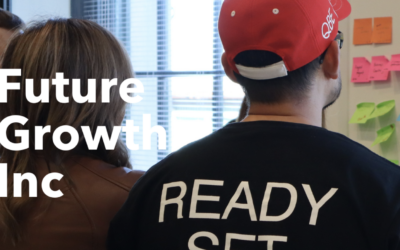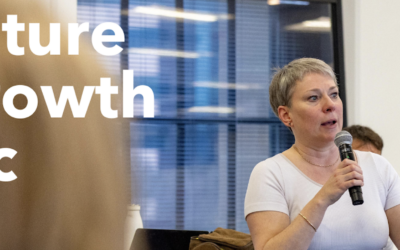Looking down from above, the scene is one of organised chaos. Small groups huddle here, there and everywhere. What looks like a fleet of messengers, shuttle between the groups, up levels, through spaces, delivering the latest information, advice, vital sustenance. Clustered at one end, a team are busily exchanging ideas. At the opposite end of the space, one group dissolves, its members shooting through the crowd like heat seeking tentacles in search of new prey. Within moments, they too are absorbed into the chameleon-like groups that swell and release, grow quiet then explode in noise. But this organic mass of self-organising individuals is far from a random occurrence. This is Australia’s first “policy hackathon” – and it is in full swing in the offices of startup accelerator, Blue Chilli.

We’ll use the hackathon methodology to nominate, select and work together in mixed teams on new government policy ideas designed to foster the growth of innovation industries including tech startups, biotech, agtech, fintech, renewables and resources.
Funding, taxation, education, migration — everything is on the table.
With a big picture vision on the table, the Disruptor’s Handbook team were keen to be involved. Volunteering as facilitators, Gavin Heaton and Joanne Jacobs joined hundreds of others from across the country in this first-of-a-kind event.
Tapping into the powerful Our Say community engagement platform, 284 ideas were proposed, attracting almost 9500 votes and 500 comments. Those who proposed a problem were identified as “champions” and worked to attract votes, support and questions from the community via the Our Say platform. But these topics were just the starting point for the PolicyHack. Only 10 proposals would make the final list for “hacking”. There could only be 10 champions. There would, necessarily, be disappointment around the selection process, the topics and even the access and participation. But this was a bold initiative that was breaking new ground. If there were failures in the process, lessons would be learned and improvements made to the process and the system.
10 challenges and 10 champions
From the hundreds of ideas submitted, only 10 were selected. The agile or “lean” methodologies used by startups rely on consciously hypothesizing, testing the hypothesis through prototyping and iterating. It is a constraint driven process that forces us to make hard choices between strong and competing ideas. The following problem domains were identified:
- Culture
- Policies to develop innovative, agile and adaptive practices in Australian medium and large businesses (Champion: Michelle Narracott)
- Incentives to develop social enterprises (Champion: Anne-Marie Elias)
- Policies to improve gender equality and diversity within the innovation ecosystem (Champion: Nicole Williamson)
- Capital
- Incentives to encourage the use of intellectual property by Australian businesses (Champion: Tracy Murray)
- Develop incentives to attract capital to improve the quality of startup businesses and the incubators and accelerators that support them (Champion: Sebastien Eckersley-Maslin)
- Co-operation
- Improve the way that universities operate and commercialise in the innovation ecosystem (Champion: Dr Tony Peacock)
- Make government procurement and data processes more open, innovative and adaptive (Champion: Adrian Turner)
- Talent
- Activities that foster global understanding and awareness amongst people in the innovation ecosystem (Champion: Colin Kinner)
- Improve education systems to foster innovative thinking, creativity, entrepreneurship and digital skills (Champion: Erin Watson-Lynn)
- Improve and expand the New Enterprise Incentive Scheme (NEIS) to foster startups (Champion: Nicola Hazell)
The dirty art of policy hacking in practice

Supported by facilitators, the Champions would work with these self-selecting teams to narrow the focus of the problem to a “policy pitch”. Policy experts, public servants and scientists were on hand to offer advice, act as mentors and help the teams round out their proposals.
By the time the teams were formed, there was only 5 hours to articulate and agree a policy hack for each challenge. We needed to clearly:
- Understand the problem: identify a clear and present problem in the innovation ecosystem and develop a policy value proposition to address it
- Explain the impact: ensure that the policy proposal can make an impact on the challenge
- Evaluate the implementation: explain the public and private resources required to implement the policy within an achievable time frame
- Determine value for money: ensure that there is a solid understanding of cost to the taxpayer
- Identify international comparisons: has anything similar been done elsewhere?
Using lean workshopping techniques, whole forests of post-it notes were scattered across walls and windows. Discussion raged between points of view, areas of priority and interest and even the “form of words” used at each level. Teams had to form, learn to collaborate, establish a process and commit to a single, narrow solution. By lunch time almost every team had yet to agree on a clear understanding of the problem they were solving.
The presentation deadline at 3pm remained fixed and the teams continued to wrestle with their policy hacks.
A new MVP – minimum viable policy

Almost every team worked the same way.
When discussing the PolicyHack approach with one of the senior public servants, I was keen to understand her perspective. Is this “distributed research and development” approach viable and useful? “This is great. I do this every day, by myself. Here I have 150 people combining to do my job for me. I need to do a PolicyHack every week”.
The three minute policy pitch
With the clock ticking, presentations were put together, messaging refined and pitches practised. Each team had three minutes to tell their story. They were to be judged according to the criteria above. And while there really wasn’t a “winner” – certainly not in terms of the usual hackathon where the rewards accrue to a single team – the teams working with a youth-orientation and a skills focus – were clear favourites with the crowd and the judges.
In fact, Larry Marshall, CEO of CSIRO, was so taken with Erin Watson-Lynn’s team proposal to teach entrepreneurship to students, that he offered her the support of the CSIRO student program. And based in the judging comments, I half expected Shark Tank’s Steve Baxter to throw his own support into this program as well. The ask was minimal and the potential significant and visionary.
No doubt, Blue Chilli and Wyatt Roy’s office will make the “official pitch videos” available as soon as possible.
The PolicyHack is the beginning not the end of the process
So, with hundreds of people dedicating their time, expertise and energy to Wyatt Roy’s PolicyHack, what happens next? There are a number of ways forward – but the politicians and public servant mentors kept advising us – the policy wheels move slower that what we have seen over the weekend. Here are some things I’d like to see:
- Leverage the process and scale it: This model seems to work spectacularly. But this first iteration was limited in scale and operation. We should look to run multiple instances of PolicyHack in additional locations across Australia, perhaps tackling additional challenge areas that did not make the cut for this round.
- Test and learn in other policy domains and jurisdictions: While the focus for this PolicyHack centred on the innovation economy – there is clear benefits to citizens, public servants and politicians in this accelerate form of consultation. Let’s see more Ministers at State and Federal level taking the plunge.
- Drive transparency in policy process: How can we track the way that these proposals make their way through the gates of policy implementation? Are there timelines? Is there a way to signal when a milestone has been reached and passed? A website that showcased this movement would help communicate the sometimes lengthy process from idea to implementation (much in the way that we build innovation dashboards to track progress of our startups).
There is bound to be additional coverage and analysis of PolicyHack in the days ahead. It was a great start but like any startup, it needs to be driven with an entrepreneurial spirit. Can Wyatt Roy be that entrepreneurial minister? Rose Powell suggests that Wyatt has his eye on a bigger picture.
“This is just the start. The hackathon itself was never the end game,” Mr Roy said.
“It is the beginning of a very serious engagement and we need look at the reality of these changes. If we’re spending taxpayer money we need to value that properly, and if there are existing schemes that can be improved, we can start there as we move forward.”



